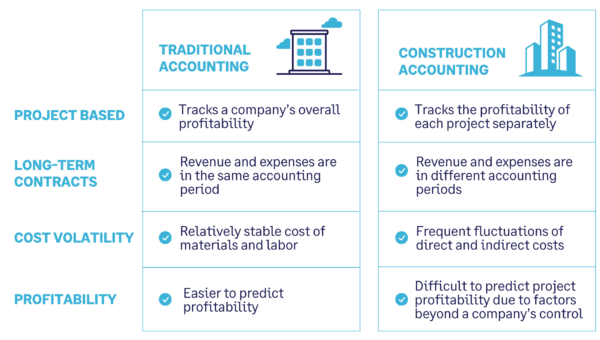A Comprehensive Guide to Building And Construction Accounting: Enhance Your Financial Administration
Efficient monetary management is crucial in the construction sector, where the intricacies of project-based profits and costs can considerably impact total earnings. By utilizing best practices in monetary reporting and evaluation, stakeholders can not only enhance functional effectiveness but additionally alleviate potential threats.
Comprehending Construction Accounting
Recognizing building accounting is crucial for the successful monitoring of funds in the building industry. This customized branch of bookkeeping addresses the one-of-a-kind difficulties faced by building companies, including project-based earnings recognition, price tracking, and conformity with regulatory needs. Unlike traditional audit, construction audit requires a distinctive method to take care of the complexities connected with lasting contracts and changing costs.
Secret parts of construction bookkeeping consist of accurate profits recognition, which usually relies on the percentage-of-completion approach or completed-contract technique, relying on the task's nature. This guarantees that monetary declarations reflect true performance and earnings with time. Job costing plays a necessary duty, permitting companies to track expenditures linked with details tasks, which assists in establishing profitability and source allocation.
Another crucial aspect is the management of capital, which is usually influenced by settlement timetables and hold-ups in receivables. Efficient capital management ensures that building and construction firms can satisfy operational needs and invest in future tasks. Eventually, grasping construction accounting equips companies with the tools required to make informed economic choices, reduce risks, and boost general operational performance in an affordable industry.

Task Costing and Budgeting
Job costing and budgeting are integral parts of building and construction audit that allow firms to effectively manage task funds and make sure success. Job setting you back entails the careful tracking of all prices related to a particular project, consisting of labor, materials, equipment, and expenses. This process allows building and construction business to ascertain the real expense of completing a task, helping with informed decision-making and boosting economic liability.
Budgeting, on the other hand, works as a financial roadmap for jobs. It entails establishing economic limitations and alloting sources to various project components, thereby developing a framework versus which actual prices can be measured. Reliable budgeting requires detailed analysis and projecting, taking into factor to consider historical information, market trends, and prospective threats.
Together, work costing and budgeting supply the necessary devices for construction firms to check financial efficiency, recognize variances, and change strategies as needed - construction accounting. By applying durable job setting you back practices and sticking to well-structured spending plans, companies can enhance their functional efficiency, reduce monetary threats, and ultimately enhance their earnings in an affordable marketplace. Thus, these methods are essential for maintaining lasting success within the building and construction industry
Tracking Costs and Profits
Properly tracking expenditures and revenue is vital for building companies to keep economic wellness and make certain project viability. Effective tracking allows companies to keep track of job performance, determine expense overruns, and make notified monetary decisions. Executing a systematic method to tape-recording all financial transactions is essential to achieving this goal.
Utilizing building and construction audit software program can dramatically boost the monitoring process. These tools facilitate real-time surveillance of expenditures, consisting of labor, materials, and subcontractor costs, while additionally recording profits produced from project landmarks and customer repayments. By classifying expenses and income streams, companies can acquire understandings right her comment is here into profitability and capital.

Financial Coverage and Analysis
Economic reporting and evaluation play an essential role in the building and construction market, providing stakeholders with crucial insights right into a firm's economic performance and functional effectiveness. Accurate monetary records, including annual report, earnings declarations, and money circulation statements, are basic for evaluating the wellness of a building and construction business. These records help recognize trends, examine project earnings, and facilitate notified decision-making.
In building and construction bookkeeping, economic analysis goes beyond plain reporting; it includes looking at financial data to reveal underlying patterns and abnormalities. Key efficiency indications (KPIs), such as gross profit margins, job conclusion prices, and return on investment, work as standards to gauge operational success. On a regular basis analyzing these metrics enables companies to recognize locations requiring enhancement, enhance source appropriation, and enhance project administration methods.
In addition, effective financial reporting promotes openness and builds trust with stakeholders, including clients, providers, and financiers - construction accounting. By preserving strenuous economic oversight, building and construction business can alleviate dangers, ensure compliance with regulative demands, and eventually drive sustainable growth. Thus, a robust financial reporting and analysis structure is essential for browsing the intricacies of the building and construction landscape and attaining long-lasting success
Finest Practices for Success
To accomplish success in building bookkeeping, companies must adopt a collection of ideal methods that enhance operations and enhance financial monitoring. Carrying out a robust task administration software customized for building can facilitate real-time monitoring of job prices and budget plans, allowing for even more accurate projecting and resource appropriation.
Second, embracing a regular technique to work costing is critical. This includes diligently tracking all costs related to each job, consisting of labor, materials, and expenses. Regularly examining work costs versus first estimates assists recognize variances early, allowing prompt rehabilitative actions.
Third, preserving strenuous documents practices guarantees compliance with guidelines and streamlines audits. This consists of maintaining detailed records of contracts, change orders, invoices, and receipts.
Furthermore, investing in personnel training is necessary. Making certain that employees are well-versed in accounting principles, software usage, and industry standards can significantly improve efficiency and accuracy in financial coverage.
Verdict

Comments on “Construction Accounting Strategies to Minimize Overhead and Boost Profit”